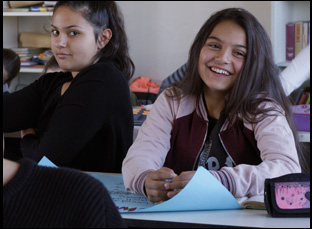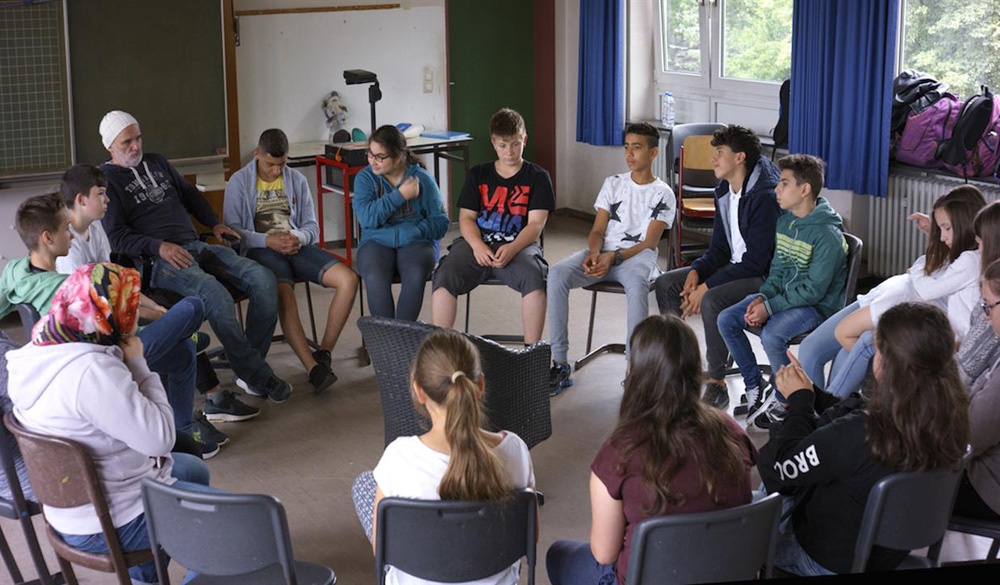“All this grading is really stressing me out,” a colleague confides in Dieter Bachmann at the Georg Büchner Comprehensive in Stadtallendorf, a school where empathy is never in short supply in “Mr. Bachmann and His Class.” You know that Mr. Bachmann surely can lend a sympathetic ear, introduced in a skullcap and AC/DC T-shirt that announces to his own sixth-year students that evaluating them with letter grades would be doing a disservice to them both, instead listening to how they approach the musical instruments that sit in the corner of his classroom and engaging them in playing the drums and guitar while sneaking in a lesson about being careful of taking advantage of one another when one instrument is played a little louder than another. (He may come off a bit selfish himself in getting them to play “Knockin’ on Heaven’s Door,” so he can sing it, but rather than appearing as self-indulgence, it’s a sign of vulnerability he hopes all can draw on.)
Mr. Bachmann would seem to stand out at the school, but that would be the last thing he’d want, given how he knows how many are trying to fit in in Stadtallendorf, a German town where one can hear more Turkish or Russian spoken than the native tongue as a haven for recent refugees and immigrants and when teaching classes where it isn’t uncommon to be communicating with students who were raised speaking a variety of different languages, he slyly guides everyone towards activities that can involve them all. His grace is matched by that of Maria Speth and cinematographer Reinhold Vorschneider, who were inspired to capture their longtime friend’s work for posterity and have ended up with a most magnificent cinematic experience. A monumental three-and-a-half hour chronicle of a school year, “Mr. Bachmann and His Class” beautifully relays the ongoing exchange between teachers and their pupils that can be so enriching to both if they’re open to listening to one another, taking its time to show the gentle evolution in thought that occurs when exposed to different experiences than one’s own to be more compassionate towards each other.
For Speth, who has largely worked in narrative – even her previous feature-length documentary “9 Liben” was filmed in a studio where the unhoused could talk about their lives – the film might’ve been an opportunity to learn as well, making her first film in the style of a Frederick Wiseman-style observational study, but surely the keen eye and open heart on display in every frame of “Mr. Bachmann and His Class” made any adaptation easy and with the film making its way onto American shores for the first time this week at DOC NYC (and available anywhere in the U.S. virtually on their online platform) after becoming a sensation at Berlinale where it won the Silver Bear Jury Prize, she spoke, with the help of a translator, about how she brought years of research both direct and indirect to tell a story about the changing face of her native country of Germany, ensuring it had the rousing spirit she experienced herself being in Mr. Bachmann’s class and the long editing process required to get at its essence.

We’ve known each other for 30 years because he’s a close friend of the cameraman Reinhold Vorschneider, who also shot the film, and he gave the impulse for me to make the movie because he told me about the city where he works as a teacher. It was a long process. I researched for many, many years, and I [initially] started working with 10th grade students about the question of how is it when you fall in love in a place like this? This city is the other protagonist of the film, and it only exists because the Nazis were building weapons there. It was the biggest production site for Nazi weapons in Europe at the time and before that, it was just a village, so the whole immigration history of Germany is reflected in this town because after the war, a new industry settled down in this area. One migration wave after another came to this place and that’s how so many different nationalities come together – I think 70 different nationalities.
That’s why I thought it was interesting to start with a question about first love and what happens, for example, when a Turkish boy falls in love with a Russian girl. Is it okay? Does it lead to any sort of conflicts? And what’s particularly interesting about this place is it’s in the countryside, and a population structure like this [typically] only exists in the larger city. Mr. Bachmann was always part of this project, but more on the sidelines in the beginning, and because I wasn’t able to get as much funding as I wanted to for the project, his sixth grade [class] started to become the center of the project. I started focusing more on that one grade instead of the whole school community.
It’s quite intricately structured so you’re getting glimpses of the town and never explaining it so much to overwhelm the sensation of how the kids are experiencing it. What was it like to find that?
It was clear for me from the beginning that I would be telling this story in images of the town. it’s really interesting that, for example, the train tracks that were used by the Nazis to transport weapons out of this town are still there. These buildings that you see in the film with these trees growing on the roof, those were always there and those are the Nazis’ buildings now being used by other industries, and also by families that use those places as apartments, so I wanted to show all of that as a kind of tableau. It was very fascinating for me to visit this town in the beginning because you have this old structure with these old traditional houses and the Catholic Church and at the same time, you have the mosques and a whole new infrastructure that was built to accommodate these whole new inhabitants. The air smells like a mix of chocolate and iron because of these two industries that you find there – Ferrero and there’s an iron plant there as well, so the question was how can all these people live together in this small place? How do they manage? The school was an ideal place to [present] that because everybody needs to go to school, so it all comes together. It was very important for me to research for a long time and to be able to approach this question from very different angles.
I understand you had a 21-hour assembly cut. What was important for you to keep as the film got to its natural length?
The editing process was really the most challenging aspect because I had so much material from the school and I first tried to organize it by topic and by character. It was important for me to not lose the multiplicity of themes and perspectives and to give space to everyone in the class and not make this film about just the teacher Mr. Bachmann, but about all the characters that formed the class, as well as the city and the history. Those were the layers. Another part of the challenge in the editing process was not to lose these small moments of joy, these moments with the children that were emotionally significant for me, and we made jokes about [how] this may become my first comedy that I’ve made. After shooting, we could always see all the emotions that were present that day, [which] was very beautiful to see that because these were children who live in precarious positions, their parents are industry workers and they don’t have so much money.
When this was filmed in 2017, what’s it like being able to reflect back on this with some distance?
One of the most striking parts about this process was I wasn’t expecting it to take three years to edit. This was also painful because when I said goodbye to the children, I said I’d be back maybe within a year, but I knew I had to focus on editing and I should not have contact with the community during that period, so that led to a period of four years in which I didn’t see them. I knew that they wouldn’t understand why this needs to be like that, that they don’t understand the filmmaking process, but I always hoped that I would be able to go back with a movie.
In this process, the children became young adults and it was very hard for me to get the film to them. The pandemic came and [after] Berlinale and only in May this year was I able to show them the film in a theater, [which] was very important because I wanted them to see themselves big on screen because for me they are the stars of the film. It was a really beautiful screening. We were able to pick up where we had left it four years earlier and everybody was really cheerful and clapping and really participating and enjoying. After these four years, it was really important for me to show the possibilities that a teacher can open up and all Mr. Bachmann taught these students beyond the curriculum, so after all this time, it was important for me to show how important it is to meet in person as well.
“Mr. Bachmann and His Class” is screening at DOC NYC at the Cinepolis Chelsea on November 10th at 7:15 pm and November 14th at 11:15 am. It will also be available on the DOC NYC virtual platform from November 11th-28th.




